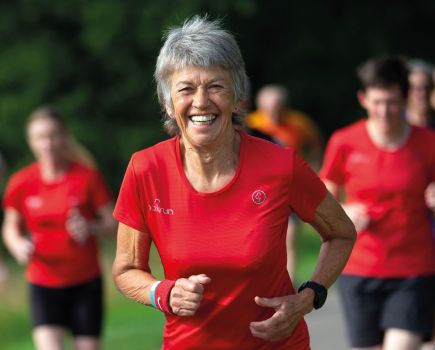How Trauma Release or shaking exercises can relieve stress and anxiety. Try these easy at-home moves
Do a quick scan of your body now – are you clenching your jaw? Are your shoulders tensed up around your ears? If you carry stress in your tightened muscles without really noticing, you’re not alone.
But help could be at hand from an unlikely source – giving yourself a good shake.
What is shaking therapy?
Trauma Release Exercises (TRE) are simple movements designed to let your body shake, which is believed to release tension, stress and trauma. Developed in the 1990s by Dr David Berceli, it’s been used around the world to help release people from anything from day-to-day anxieties, to the symptoms of PTSD in war zones.
‘Our stress response is designed to help us escape an enemy, such as a tiger,’ says Steve Haines, the UK’s leading TRE practitioner. ‘Your muscles get tight, your heart starts pumping and your pupils get wider. Obviously there are certain circumstances where that’s useful, but many people find that the pressures of modern life leave this response “switched on”, which can overload your heart, make you tired and cause anxiety. It also means that your body doesn’t prioritise non-urgent systems such as digestion or your immune system. This kind of stress is implicated in just about every major health problem you can suffer.’
Left unchecked, stress can cause issues with libido, fertility, and digestive problems and, of course, make you feel very unhappy. Chronic stress has been shown to affect the body’s inflammatory response, influencing the spread and severity of disease, according to American research.
Around 23.9 days of work were lost on average in 2017 by people affected by stress, according to the Health Executive Agency.
Why are we so stressed?
People come to TRE from many different situations, whether they’ve experienced childhood trauma or are simply overwhelmed by a busy life. There’s no doubt that our hyper-connected world has led to more of us missing out on sleep and struggling to confine work to the hours of 9-5. ‘Sadly, many people have had adverse experiences in childhood, which have left them primed to react to situations in a certain way.
Even if that’s not the case for you, the world is a stressful place. A few decades ago there was minimal choice when you went to buy food, but now you’ve got 15 varieties of rice to choose between,’ says Steve. ‘Our brains didn’t evolve to process that much information. It’s easy to feel overwhelmed.’
How can shaking help release stress?
When your life feels exhausting or if you’ve experienced a traumatic event, your body may go into a ‘freeze’ response. ‘It’s where we numb ourselves to outside events,’ says Steve. ‘Shaking is a natural model to reset your body when it’s braced against life. Our brains and our muscles get stuck in a certain state, and this is a way of releasing tension.
‘The good news is that, just as we can turn on this state of high alert very quickly, it’s also a quick process to turn it back off again. TRE can provide relief from stress, tension and trauma, stimulate your nervous system, optimise control of your muscles and help you feel reconnected with your body.’
While many people suffering from PTSD might shy away from reliving painful experiences, the bonus of TRE is that it’s an entirely physical therapy, and can be performed in a class, with a teacher or at home alone.
The effects, according to Steve, can be significant and speedy. ‘I’ve had clients say it’s like getting their body back, or learning to feel joy again. Outside of the practice it can help you regulate intense feelings, whatever your trigger is.’
Try Trauma Release Exercises at home
‘The feeling of shaking is pleasant once you get used to it,’ says Steve. ‘It should feel effortless and quite curious.’ There are seven basic exercises to get the full TRE experience, to get a taster, give these two a try.
Stretch your legs
- Stand with your legs spread apart so there is some tension on the inner muscles.
- Bend forward to touch the ground. You’ll feel a stretch on the inner thigh and backs of the legs.
- Slowly walk your hands over to one foot and hold this position for three slow breaths.
- Then walk your hands over to the other foot for three breaths.
- Walk your hands back to the middle and reach behind you through your legs for three breaths. If you feel your legs shaking, just allow it to happen
Open up your hips
- Lie flat on your back, putting the soles of your feet together and letting your knees fall open as wide as they comfortably can. Relax for a minute.
- Raise your pelvis off the ground about three inches, keeping your knees open. Hold this position for one minute.
- Return to the first position for a minute.
- Close your knees about an inch, and hold for two minutes. Allow any quivering to happen.
- Over time, close your knees another inch and hold for a minute, and then once more.
- You may find quivering turns into shaking – just allow it to happen. Let your feet slide down so you’re lying flat. Stay there for three minutes and get up slowly.
NOW READ: Can yoga help depression?








